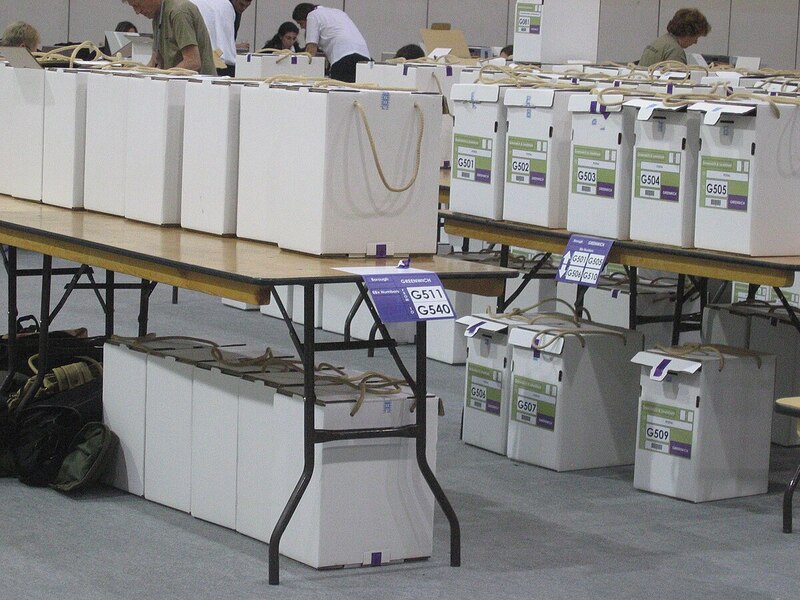Guidance for attending 'The Count'

Attending the DCC Elections Count
Thurs 1 May 10pm - 1am (ish), Riverside Leisure Centre
If you're interested in attending, follow this link to our form.
Why do we need 'counting agents?
Thank you for expressing an interest in being one of Exeter Green Party's Counting Agents.
- The count provides us with key intelligence about where our Green voters are within a given area. This informs our decisions on future local election campaigns.
- It's our opportunity to monitor the counting of votes and to challenge mistakes which may be made; and if the vote is very close, it’s our opportunity to request a recount.
- Our candidates deserve the support of party members at this key moment, whether they win or lose
- It's a positive thing for a large group of Greens to show up, boosting our credibiity in the eyes of the other local parties
- It's a very enjoyable and exciting experience- democracy live in action!
This guidance explains the importance of the count, and what volunteers, agents and candidates need to do, particularly during the crucial verification phase. As part of the pack, a sample tallying sheet is provided. During the count itself, you can contact your regional staff for help where needed.
What happens at the count?
After polls close, boxes of ballot papers are sealed and brought to the count. They are then opened and counted, but it’s not quite as simple as you might think - here’s what will happen.
There are four key phases which take place at the count :
- Verification - ballot boxes are opened, ballot papers are unfolded and the number of ballots are counted and compared to how many were expected to be in each box. Counting agents at work here
- The Count - when votes are sorted according to party.
- Adjudication - ballots where it’s unclear who people voted for are looked at by the returning officer and election agents and it’s agreed how to count them.
- Results - Result announced to candidates and agents, with a chance to challenge (it’s publicly announced only after this point).
The whole process typically takes around 5 -6 hours, from arrival of the ballot boxes to announcing the winners.
Verification
Ballot boxes are opened, each ballot paper is unfolded, and the number of ballots is counted. They are then checked
against the recorded number of votes to check for fraud.
Ballot boxes are opened one at a time, and you should be told which polling district each box comes from (if they
don’t tell you, you can ask).
Once the ballot box has been opened (usually one box per polling district but sometimes two) each ballot paper will be
unfolded and placed in a pile, facing upwards - this phase is crucial as it gives us a chance to see where our votes
are, broken down by polling district.
This is our only opportunity to find out how many people voted for us in each polling district. With the right approach,
the verification process can provide us with vital information to help us build our campaign for years to come.
What we need to do:
- During 'verification', you will be assigned to a ballot box from one of the polling districts.
- As the box is opened you should be told which polling district the box comes from, make a note of this on your tallying sheet (if they don't tell you, you can ask).
- Once the ballot box has been opened, each ballot paper will be unfolded and placed in a pile, facing upwards.
- Shadowing one person who is unfolding and piling up each ballot, you need to aim to make a tally of all votes on your tallying sheets.
- This isn’t a precise science as it’s hard to count every single vote, but if you have one volunteer (called a “counting agent” officially) shadowing each person unfolding ballot papers, you should do OK.
Your election agent - or a volunteer overseeing this process - should remain vigilant for announcements of the opening of each new ballot box. The person overseeing this process can also gather in the sheets, and try and work out how the results are looking.
Counting the votes
Next, the count proper begins. This is where ballots from various boxes are mixed together, then distributed to count staff who look at each vote and then place it in that candidate’s party’s pile.
The key thing is to watch that Green Party papers are put on the Green Party pile, not the pile of another party.
Votes will be bundled into 100s, so you need to make sure Green Party piles of 100 are kept together, and that no-one puts a single Labour vote on top of 99 Green Party votes and tries to make out it’s a “Labour” pile of 100 (this has happened on multiple occasions…).
Materials needed for the count:
- Pens
- Clipboards
- Tallying sheets
- Snacks (the whole process can take a long time)!
Volunteers for the count:
- Team Leader/Coordinator (often the Election Agent)
- Counting Agents (minimum of 1 per division)
- Candidates and/or their guests can help too.